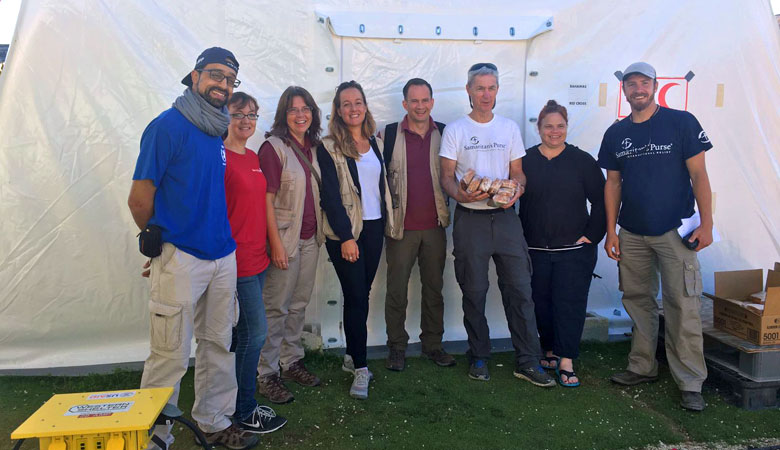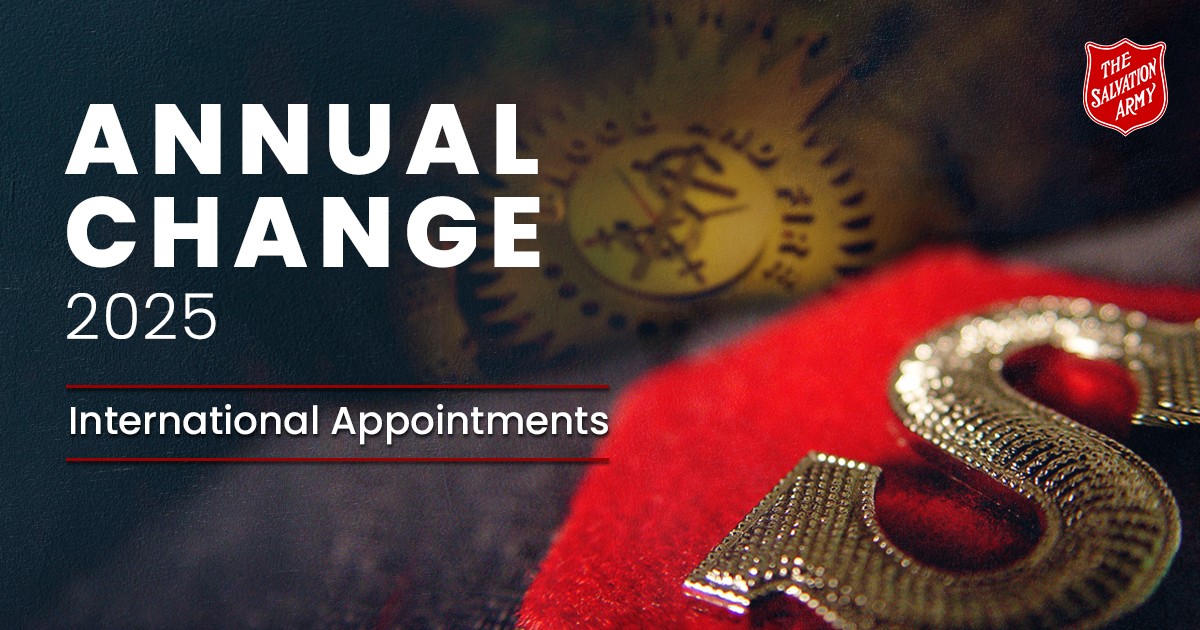(Above) Carolynn Barkhouse (third from left) with emergency response personnel from various agencies in Abaco, Bahamas
International Emergency Services has asked for you to deploy to Mali for two months to assist with our response to the civil war.” Those words were spoken to me seven years ago by Major Rick Shirran, then territorial director of emergency disaster services. Those words thrilled me. Those words scared me. Those words were the start of a new calling.
Since that first call in 2013, I have deployed with International Emergency Services (IES) four times. In many ways, IES is similar to emergency disaster services (EDS). The initial focus of the response is on relief activities: feeding, goods-in-kind (GIK) distribution, emotional and spiritual care, or all of the above. However, IES teams also work to build local Salvation Army capacity and improve disaster resilience within the affected community. Guided by international humanitarian standards, we work to assist the community in becoming more self-sufficient, implementing solutions that integrate disaster risk reduction principles. Only one step on the relief-recovery continuum, IES projects often lead to longer-term development projects such as building toilets, replanting coconut tree farms or starting livelihood training centres. You may learn more about cholera than you ever wanted to know. But that’s the calling.
Similar to EDS, IES personnel work in teams. However, IES teams are typically small—only three to five members—the management team members are also frontline workers. Even the team leader will at some point take part in loading goods onto a truck, registering beneficiaries or conducting door-to-door needs assessments. But that’s the calling.
IES teams are made up of trained personnel from across the Salvation Army world. They come with as many cultures and norms (and sometimes languages) as there are members, working in another country with yet another culture and set of norms (and sometimes language). Deployments are long—usually two to three months—and hardship living conditions are almost always in place. Think black mould, rats in the attic, termites, a leaking roof during rainy season, power outages, no running water—the list goes on. You must be willing to do whatever and live wherever with whomever to be an IES deployee. But that’s the calling.
Deployed to the Bahamas
I deployed with IES to the Bahamas last September, two weeks after a massive category 5 hurricane hit the country. Hurricane Dorian affected three islands, each one so differently that, in effect, it was like responding to three different disasters simultaneously.
New Providence experienced minimal localized flooding and so became the evacuation site for evacuees from other islands. Our response there included running an evacuation shelter and supporting government-led shelters with GIK. Grand Bahama faced major flooding, which led to significant black mould issues. There, we focused on GIK distribution and mould remediation education.
The central part of Abaco was completely devastated; neighbourhoods were wiped out and the economic infrastructure was totally destroyed. With no permanent Salvation Army presence on this island, our response centered on GIK distribution through other agencies. We also partnered with other organizations to conduct community needs assessments to determine how best we could respond. Even as our response continues today, we know that recovery will be years in the making.
Over my 10 weeks there, as I travelled around Abaco, I wondered how we could even begin to make a difference. Everywhere you look, there is evidence of Dorian—you cannot escape the havoc it wreaked. So much devastation. So much loss of life. And you think, How can one small team make any kind of significant impact on anyone’s life? But then you remember every ocean starts with one drop of water. Every smile brightens someone’s day. Every kind word reassures someone that others care. Every gentle touch reminds someone they are not alone. So you press on, following where God leads. One step after another, doing the work as you feel led. Seeing the jovial tourists in Nassau in juxtaposition with the utter decimation of Abaco plays with your mind. But that’s the calling.
Each of my IES deployments has been unique. Each deployment has been in a different country, has called for a different response, and has used a different combination of skills. Each one has offered a different set of challenges, sometimes stretching me outside my comfort zone. But each has also given me great joy and an affirmation that this ministry is for me. I am called by God to do IES. And I wouldn’t change it for the world—that’s my calling.
Carolynn Barkhouse is the divisional director of emergency disaster services, Alberta and Northern Territories Division
International Emergency Services has asked for you to deploy to Mali for two months to assist with our response to the civil war.” Those words were spoken to me seven years ago by Major Rick Shirran, then territorial director of emergency disaster services. Those words thrilled me. Those words scared me. Those words were the start of a new calling.
Since that first call in 2013, I have deployed with International Emergency Services (IES) four times. In many ways, IES is similar to emergency disaster services (EDS). The initial focus of the response is on relief activities: feeding, goods-in-kind (GIK) distribution, emotional and spiritual care, or all of the above. However, IES teams also work to build local Salvation Army capacity and improve disaster resilience within the affected community. Guided by international humanitarian standards, we work to assist the community in becoming more self-sufficient, implementing solutions that integrate disaster risk reduction principles. Only one step on the relief-recovery continuum, IES projects often lead to longer-term development projects such as building toilets, replanting coconut tree farms or starting livelihood training centres. You may learn more about cholera than you ever wanted to know. But that’s the calling.
Similar to EDS, IES personnel work in teams. However, IES teams are typically small—only three to five members—the management team members are also frontline workers. Even the team leader will at some point take part in loading goods onto a truck, registering beneficiaries or conducting door-to-door needs assessments. But that’s the calling.
IES teams are made up of trained personnel from across the Salvation Army world. They come with as many cultures and norms (and sometimes languages) as there are members, working in another country with yet another culture and set of norms (and sometimes language). Deployments are long—usually two to three months—and hardship living conditions are almost always in place. Think black mould, rats in the attic, termites, a leaking roof during rainy season, power outages, no running water—the list goes on. You must be willing to do whatever and live wherever with whomever to be an IES deployee. But that’s the calling.
Deployed to the Bahamas
I deployed with IES to the Bahamas last September, two weeks after a massive category 5 hurricane hit the country. Hurricane Dorian affected three islands, each one so differently that, in effect, it was like responding to three different disasters simultaneously.
New Providence experienced minimal localized flooding and so became the evacuation site for evacuees from other islands. Our response there included running an evacuation shelter and supporting government-led shelters with GIK. Grand Bahama faced major flooding, which led to significant black mould issues. There, we focused on GIK distribution and mould remediation education.
The central part of Abaco was completely devastated; neighbourhoods were wiped out and the economic infrastructure was totally destroyed. With no permanent Salvation Army presence on this island, our response centered on GIK distribution through other agencies. We also partnered with other organizations to conduct community needs assessments to determine how best we could respond. Even as our response continues today, we know that recovery will be years in the making.
Over my 10 weeks there, as I travelled around Abaco, I wondered how we could even begin to make a difference. Everywhere you look, there is evidence of Dorian—you cannot escape the havoc it wreaked. So much devastation. So much loss of life. And you think, How can one small team make any kind of significant impact on anyone’s life? But then you remember every ocean starts with one drop of water. Every smile brightens someone’s day. Every kind word reassures someone that others care. Every gentle touch reminds someone they are not alone. So you press on, following where God leads. One step after another, doing the work as you feel led. Seeing the jovial tourists in Nassau in juxtaposition with the utter decimation of Abaco plays with your mind. But that’s the calling.
Each of my IES deployments has been unique. Each deployment has been in a different country, has called for a different response, and has used a different combination of skills. Each one has offered a different set of challenges, sometimes stretching me outside my comfort zone. But each has also given me great joy and an affirmation that this ministry is for me. I am called by God to do IES. And I wouldn’t change it for the world—that’s my calling.
Carolynn Barkhouse is the divisional director of emergency disaster services, Alberta and Northern Territories Division










Leave a Comment